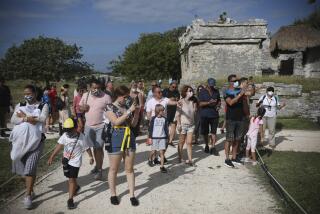Cancun Celebrates 12th Birthday as Tourist Stop
- Share via
CANCUN, Mexico — In this year of a 100th anniversary for the Statue of Liberty, a 150th celebration for Hans Christian Andersen and the same for the state of Texas, let’s share a few moments in remembering a 12th birthday.
It was in 1974 that Cancun on Mexico’s Caribbean coast of the Yucatan Peninsula opened for tourism with the hope that it would become an instant Acapulco, or at the very least an overnight Puerto Vallarta--without the assist of a Liz Taylor and Richard Burton romance.
Tourism had already begun to blossom into Mexico’s most promising industry. A few years earlier, future-minded economists in the Central Bank and several private banks saw a need for another Acapulco to relieve their prime-destination city, deluged with tourists and in need of refurbishing. They poured an enormous amount of data into computers and asked where the counterpart to Acapulco should be built.
Ribbon of Sand
Computers and human data-sifters came up with the answer: Cancun, then little more than a ribbon of sand looping close to the Caribbean coast in the shape of the No. 7.
It was about a dozen miles long and less than a quarter-mile wide. The location could be romanced as an island, joined to the mainland by two small bridges that would also create a causeway effect as in the Florida Keys.
The beaches were a luminescent white from the limestone base in the sand, and tended to feel cool to bare feet even under the noonday sun.
There were more than 200 rain-free days a year. The average temperature was 80 degrees and the waters were Caribbean warm. Beaches facing the sea enjoyed a swell that would attract surfers. Beaches looking across the lagoon to the mainland rippled with tranquil water and sloped so gently that a bather could wade out a hundred yards.
The cruise-port island of Cozumel, sacred to the ancient Maya civilization as the earthly home of the Moon Goddess, was just 20 minutes by air offshore, about an hour by ferry. Miami was within an hour and a quarter by air, Mexico City less than two hours.
Government Support
Fonatur, the Mexican government agency charged with planning resorts, took over the planning of a super-resort that would be an Acapulco on the Caribbean. The government, with the help of private capital and an economy that then enjoyed substantial oil revenues, invested more than $80 million in an infrastructure of highways, water and power lines, an international airport.
The mainland settlement at the end of the island causeway at that time had a population made up of about 20 families of cotton pickers. A modern city would have to be built there to house the workers and support structure for all the posh hotels expected to be constructed on the narrow island of white-sand beaches. And of course there would have to be a Robert Trent Jones golf course.
Even in modern tourism, the span of a dozen years can seem like the blink of a cosmic eyelid. So what has happened in these 12 years? Will this birthday one year short of teen-age be celebrated with the realization of a tourism dream?
With a rental car and my wife Elfriede’s camera poised for many stops, we have slowly explored the island and the mainland city. We walked along beaches, swam for hours in the soothing water, enjoyed a tranquil and scenic bicycle path.
The basic discovery is that Cancun is neither an instant Acapulco nor an overnight Puerto Vallarta. In 12 short years it has developed its own Mexican Caribbean personality.
Population Explosion
One key statistic gives a clue to the answers we were seeking: The community that began with about 20 families of cotton pickers has grown to a city of about 100,000, geared primarily to support tourism on the narrow causeway island.
The city is a destination, but let’s start with the island, now drawing a steadily increasing number of visitors from California and the West Coast to supplement the base of tourism from the East Coast, the Middle West and Canada.
Growth and the height and style of hotel architecture have been carefully regulated. There is no wall-to-wall high-rise, and hotels are interspersed with residential areas and public beaches. Innovation is encouraged, whether it reflects influences of Spain, Egypt, Italy or the Mayans, whose architects harmonized their great edifices with nature.
The deluxe Cancun Sheraton filled its grounds with tropical plants and preserved the Maya ruin next to the beach. Fiesta Americana and its pastel wings with balconies is reminiscent of an Italian hill town.
Surrounded by sea and lagoon, the prestigious Hotel Camino Real is a combination of magnificent contemporary architecture and courtyards verdant with Yucatan foliage. The Krystal Cancun has a touch of Greece. The El Presidente, where we made reservations by phoning from Cozumel, is modern Mexican in styling and decor, with landscaping to enhance the Caribbean mood. Miramar Mission combines the latest in amenities with a feel of the mission age.
Jungle and Club Med
The island has its own bit of jungle around the Maya ruins of El Rey, The King. Club Med has also come to Cancun island, in its own domain out on Punta Nizuc.
Robert Trent Jones was invited early to the wispy island. He designed the 18-hole Pok-ta-Pok course between two lagoons. If you have time to play only one hole, make it the 12th.
I carry one club while traveling. The shaft telescopes to suitcase size, the head has every setting from wedge and putter to driving iron. As I lined up an approach shot on the 12th, I became aware of a most unusual hazard: a Maya ruin uncovered when the course was graded. It has been preserved with every archeological care.
This Club de Golf also has tennis courts, as do most of the major hotels. Water sports on the island include windsurfing lessons, deep-sea fishing, swimming, snorkeling, scuba diving, water skiing and sailing. The surfaced and shaded bicycle path winds for half a dozen miles between the beaches and the island road. Inexpensive bike rentals can be arranged through your hotel concierge.
Of almost 50 Cancun hotels and resorts, nearly 20 of the smaller and most economical are in the city. The Cancun Hotel and Motel Assn. has prepared a complete listing. It includes a map of the island and city, highlights of attractions, activities and services.
Art, Old and New
The Anthropology Museum beside the Convention Center on the island has a collection of Maya artifacts that includes a staircase with hieroglyphics from the 6th Century. Two Cancun galleries display the works of well-known Mexican artists; limestone carvings by Gilbert Silva are at La Galeria in Costa Blanca shopping center. Monuments along Paseo Kukulcan and Avenida Tulum are already preserving the history of this 12-year-old city. Bellas Artes cultural institute will soon open a Casa e la Cultura in Cancun.
Shopping for everything from handworked Mexican pottery to imported French perfume bargains is tucked away in four plazas on the island and along avenues in the city. Plaza Mexico on Avenida Tulum is a pyramid-shaped mall on two levels.
Every major hotel has a range of restaurants and cuisines. At El Presidente a pianist played during the cocktail hour, mariachis moved from table to table during dinner. Well-known restaurant names along the boulevards include Carlos ‘n’ Charlie’s, Chac-Mool and an elegant Maxime with French specialties. The Happy Lobster is a sidewalk cafe. Discos rev up about 10:30 p.m. and keep going until sunrise.
Highways out of Cancun City invite excursions south to Tulum, Coba and Quintana Roo’s capital city of Chetmal, west to the ruins of Chichen Itza. Favorite excursion by sea is the ferry ride out to Isla Mujeres, the Isle of Women, out on the Caribbean horizon.
Luncheon Cruises
That was the Maya isle of fertility rites. Today it is an excursion for snorkeling and diving, and to enjoy the quiet village. A sailboat and a trimaran make luncheon cruises to the isle. Near it is the famed Cave of Sleeping Sharks filmed by Jacques Cousteau. The sharks can be seen asleep in this tranquil underwater cave. They pay no attention to divers.
Mexico’s troubled economy and the declining value of the peso is reflected in Cancun as elsewhere in Mexico. Prices raised to offset the falling peso can still be moderate for U.S. visitors. Our room at El Presidente was 26,000 pesos a night, about $65.
Airlines flying to Cancun International Airport from Los Angeles and the West Coast include Mexicana, Aero Mexico, Continental and American. Check with your travel agent for special rates and packages that may be available at time of departure.
For information about Cancun, the state of Quintana Roo and the Yucatan Peninsula, contact the Mexican Government Tourist Office, 10100 Santa Monica Blvd., Suite 224, Los Angeles 90067, phone (213) 203-8151.
More to Read
Sign up for The Wild
We’ll help you find the best places to hike, bike and run, as well as the perfect silent spots for meditation and yoga.
You may occasionally receive promotional content from the Los Angeles Times.






